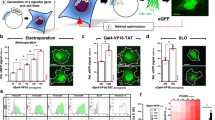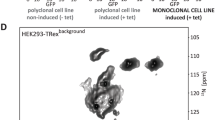Abstract
A large number of proteins carry out their function in highly flexible and disordered states, lacking a well-defined 3D structure. These proteins, referred to as intrinsically disordered proteins (IDPs), are now in the spotlight of modern structural biology. Nuclear magnetic resonance (NMR) spectroscopy represents a unique tool for accessing atomic resolution information on IDPs in complex environments as whole cells, provided that the methods are optimized to their peculiar properties and to the characteristics of in-cell experiments. We describe procedures for the preparation of in-cell NMR samples, as well as for the setup of NMR experiments and their application to in-cell studies, using human α-synuclein overexpressed in Escherichia coli as an example. The expressed protein is labeled with 13C and 15N stable isotopes to enable the direct recording of 13C-detected NMR experiments optimized for the properties of IDPs. The entire procedure covers 24 h, including cell transformation, cell growth overnight, setup of the spectrometer and NMR experiment recording.
This is a preview of subscription content, access via your institution
Access options
Subscribe to this journal
Receive 12 print issues and online access
$259.00 per year
only $21.58 per issue
Buy this article
- Purchase on SpringerLink
- Instant access to full article PDF
Prices may be subject to local taxes which are calculated during checkout






Similar content being viewed by others
References
Bertini I., McGreevy, K.S. & Parigi, G. (Eds.) NMR of Biomolecules: Towards Mechanistic Systems Biology. (Wiley-VCH, 2012).
Dyson, H.J. & Wright, P.E. Intrinsically unstructured proteins and their functions. Nat. Rev. Mol. Cell Biol. 6, 197–208 (2005).
Serber, Z. et al. High-resolution macromolecular NMR spectroscopy inside living cells. J. Am. Chem. Soc. 123, 2446–2447 (2001).
Selenko, P. & Wagner, G. Looking into live cells with in-cell NMR spectroscopy. J. Struct. Biol. 158, 244–253 (2007).
Selenko, P. et al. In situ observation of protein phosphorylation by high-resolution NMR spectroscopy. Nat. Struct. Mol. Biol. 15, 321–329 (2008).
Banci, L. et al. Atomic-resolution monitoring of protein maturation in live human cells by NMR. Nat. Chem. Biol. 9, 297–299 (2013).
Felli, I.C. & Pierattelli, R. Novel methods based on 13C detection to study intrinsically disordered proteins. J. Magn. Reson. 241, 115–125 (2014).
Dyson, H.J. & Wright, P.E. Nuclear magnetic resonance methods for the elucidation of structure and dynamics in disordered states. Methods Enzymol. 339, 258–271 (2001).
Mittag, T. & Forman-Kay, J. Atomic-level characterization of disordered protein ensembles. Curr. Opin. Struct. Biol. 17, 3–14 (2007).
Kjaergaard, M. & Poulsen, F.M. Disordered proteins studied by chemical shifts. Prog. NMR Spectrosc. 60, 42–51 (2012).
Hsu, S.T., Bertoncini, C.W. & Dobson, C.M. Use of protonless NMR spectroscopy to alleviate the loss of information resulting from exchange-broadening. J. Am. Chem. Soc. 131, 7222–7223 (2009).
Skora, L., Becker, S. & Zweckstetter, M. Molten globule precursor states are conformationally correlated to amyloid fibrils of human β-2-microglobulin. J. Am. Chem. Soc. 132, 9223–9225 (2010).
Gil, S. et al. NMR studies of intrinsically disordered proteins near physiological conditions. Angew. Chem. Int. Ed. 52, 11808–11812 (2013).
Bermel, W., Bertini, I., Felli, I.C., Piccioli, M. & Pierattelli, R. 13C-detected protonless NMR spectroscopy of proteins in solution. Progr. NMR Spectrosc. 48, 25–45 (2006).
Felli, I.C., Piai, A. & Pierattelli, R. Recent advances in solution NMR studies: 13C direct detection for biomolecular NMR applications. In Ann. Rep. NMR Spectroscop. 359–418 (Elsevier, 2013).
Felli, I.C. & Pierattelli, R. Recent progress in NMR spectroscopy: towards the study of intrinsically disordered proteins of increasing size and complexity. IUBMB Life 64, 473–481 (2012).
Inomata, K. et al. High-resolution multi-dimensional NMR spectroscopy of proteins in human cells. Nature 458, 106–109 (2009).
Sakakibara, D. et al. Protein structure determination in living cells by in-cell NMR spectroscopy. Nature 458, 102–105 (2009).
Ikeya, T. et al. NMR protein structure determination in living E.coli cells using nonlinear sampling. Nat. Protoc. 5, 1051–1060 (2010).
Reckel, S., Hänsel, R., Löhr, F. & Dötsch, V. In-cell NMR spectroscopy. Prog. NMR Spectrosc. 51, 91–101 (2007).
Ogino, S. et al. Observation of NMR signals from proteins introduced into living mammalian cells by reversible membrane permeabilization using a pore-forming toxin, streptolysin O. J. Am. Chem. Soc. 131, 10834–10835 (2009).
Pielak, G.J. et al. Protein nuclear magnetic resonance under physiological conditions. Biochemistry 48, 226–234 (2009).
Theillet, F.X. et al. Cell signaling, post-translational protein modifications and NMR spectroscopy. J. Biomol. NMR 54, 217–236 (2012).
Bertrand, K., Reverdatto, S., Burz, D.S., Zitomer, R. & Shekhtman, A. Structure of proteins in eukaryotic compartments. J. Am. Chem. Soc. 134, 12798–12806 (2012).
Ito, Y. & Selenko, P. Cellular structural biology. Curr. Opin. Struct. Biol. 20, 640–648 (2010).
Maldonado, A.Y., Burz, D.S. & Shekhtman, A. In-cell NMR spectroscopy. Progr. NMR Spectrosc. 59, 197–212 (2011).
Bertini, I., Felli, I.C., Gonnelli, L., Kumar, V.M.V. & Pierattelli, R. 13C direct-detection biomolecular NMR spectroscopy in living cells. Angew. Chem. Int. Ed. 50, 2339–2341 (2011).
Serber, Z. et al. Methyl groups as probes for proteins and complexes in in-cell NMR experiments. J. Am. Chem. Soc. 126, 7119–7125 (2004).
Bermel, W. et al. Improving the chemical shift dispersion of multidimensional NMR spectra of intrinsically disordered proteins. J. Biomol. NMR 55, 231–237 (2013).
Bermel, W., Bertini, I., Felli, I.C., Kümmerle, R. & Pierattelli, R. Novel 13C direct detection experiments, including extension to the third dimension, to perform the complete assignment of proteins. J. Magn. Reson. 178, 56–64 (2006).
Bermel, W. et al. Complete assignment of heteronuclear protein resonances by protonless NMR spectroscopy. Angew. Chem. Int. Ed. 44, 3089–3092 (2005).
Bermel, W., Bertini, I., Felli, I.C. & Pierattelli, R. Speeding up 13C direct detection biomolecular NMR experiments. J. Am. Chem. Soc. 131, 15339–15345 (2009).
Bermel, W. et al. H-start for exclusively heteronuclear NMR spectroscopy: the case of intrinsically disordered proteins. J. Magn. Reson. 198, 275–281 (2009).
Bermel, W., Bertini, I., Felli, I.C., Peruzzini, R. & Pierattelli, R. Exclusively heteronuclear NMR experiments to obtain structural and dynamic information on proteins. ChemPhysChem 11, 689–695 (2010).
Schanda, P. Fast-pulsing longitudinal relaxation optimized techniques: enriching the toolbox. Prog. NMR Spectrosc. 55, 238–265 (2009).
Schanda, P., Van Melckebeke, H. & Brutscher, B. Speeding up three-dimensional protein NMR experiments to a few minutes. J. Am. Chem. Soc. 128, 9042–9043 (2006).
Serber, Z. et al. Investigating macromolecules inside cultured and injected cells by in-cell NMR spectroscopy. Nat. Protoc. 1, 2701–2709 (2006).
Sivashanmugam, A. et al. Practical protocols for production of very high yields of recombinant proteins using Escherichia coli. Protein Sci. 18, 936–948 (2009).
Hwang, T.L. & Shaka, A.J. Water suppression that works. excitation sculpting using arbitrary wave-forms and pulsed-field gradients. J. Magn. Reson. A 112, 275–279 (1995).
Schanda, P., Kupce, E. & Brutscher, B. SOFAST-HMQC experiments for recording two-dimensional heteronuclear correlation spectra of proteins within a few seconds. J. Biomol. NMR 33, 199–211 (2005).
Kupce, E. & Freeman, R. Wide-band excitation with polychromatic pulses. J. Magn. Reson. A 108, 268–273 (1994).
Geen, H. & Freeman, R. Band-selective radiofrequency pulses. J. Magn. Reson. 93, 93–141 (1991).
Andersson, P., Weigelt, J. & Otting, G. Spin-state selection filters for the measurement of heteronuclear one-bond coupling constants. J. Biomol. NMR 12, 435–441 (1998).
Ottiger, M., Delaglio, F. & Bax, A. Measurement of J and dipolar couplings from simplified two-dimensional NMR spectra. J. Magn. Reson. 131, 373–378 (1998).
Duma, L., Hediger, S., Brutscher, B., Böckmann, A. & Emsley, L. Resolution enhancement in multidimensional solid-state NMR spectroscopy of proteins using spin-state selection. J. Am. Chem. Soc. 125, 11816–11817 (2003).
Bermel, W., Felli, I.C., Kümmerle, R. & Pierattelli, R. 13C direct-detection biomolecular NMR. Concepts Magn. Reson. 32A, 183–200 (2008).
Emsley, L. & Bodenhausen, G. Gaussian pulse cascades: new analytical functions for rectangular selective inversion and in-phase excitation in NMR. Chem. Phys. Lett. 165, 469–476 (1990).
Böhlen, J.-M. & Bodenhausen, G. Experimental aspects of chirp NMR spectroscopy. J. Magn. Reson. Ser. A 102, 293–301 (1993).
Shaka, A.J., Keeler, J. & Freeman, R. Evaluation of a new broadband decoupling sequence: WALTZ-16. J. Magn. Reson. 53, 313–340 (1983).
Shaka, A.J., Barker, P.B. & Freeman, R. Computer-optimized decoupling scheme for wideband applications and low-level operation. J. Magn. Reson. 64, 547–552 (1985).
Dedmon, M.M., Patel, C.N., Young, G.B. & Pielak, G.J. FlgM gains structure in living cells. Proc. Natl. Acad. Sci. USA 99, 12681–12684 (2002).
Li, C. et al. Differential dynamical effects of macromolecular crowding on an intrinsically disordered protein and a globular protein: implications for in-cell NMR spectroscopy. J. Am. Chem. Soc. 130, 6310–6311 (2008).
Bermel, W. et al. Protonless NMR experiments for sequence-specific assignment of backbone nuclei in unfolded proteins. J. Am. Chem. Soc. 128, 3918–3919 (2006).
Binolfi, A., Theillet, F.X. & Selenko, P. Bacterial in-cell NMR of human α-synuclein: a disordered monomer by nature? Biochem. Soc. Trans. 40, 950–954 (2012).
Radivojac, P. et al. Intrinsic disorder and functional proteomics. Biophys. J. 92, 1439–1456 (2007).
Banci, L., Barbieri, L., Bertini, I., Cantini, F. & Luchinat, E. In-cell NMR in E. coli to monitor maturation steps of hSOD1. PLoS ONE 6, e23561 (2011).
Sakai, T. et al. In-cell NMR spectroscopy of proteins inside Xenopus laevis oocytes. J. Biomol. NMR 36, 179–188 (2006).
Lippens, G., Landrieu, I. & Hanoulle, X. Studying post-translational modifications by in-cell NMR. Chem. Biol. 15, 311–312 (2008).
Theillet, F.X. et al. Site-specific mapping and time-resolved monitoring of lysine methylation by high-resolution NMR spectroscopy. J. Am. Chem. Soc. 134, 7616–7619 (2012).
Lippens, G. et al. Towards the understanding the phosphorylation code of tau. Biochem. Soc. Trans. 40, 698–703 (2012).
Burz, D.S., Dutta, K., Cowburn, D. & Shekhtman, A. Mapping structural interactions using in-cell NMR spectroscopy (STINT-NMR). Nat. Methods 3, 91–93 (2006).
Burz, D.S. & Shekhtman, A. In-cell biochemistry using NMR spectroscopy. PLoS ONE 3, e2571 (2008).
Hubbard, J.A., MacLachlan, L.K., King, G.W., Jones, J.J. & Fosberry, A.P. Nuclear magnetic resonance spectroscopy reveals the functional state of the signalling protein CheY in vivo in Escherichia coli. Mol. Microbiol. 49, 1191–1200 (2003).
Banci, L., Barbieri, L., Luchinat, E. & Secci, E. Visualization of redox-controlled protein fold in living cells. Chem. Biol. 20, 747–752 (2013).
Bermel, W., Bertini, I., Felli, I.C., Kümmerle, R. & Pierattelli, R. 13C direct detection experiments on the paramagnetic oxidized monomeric copper, zinc superoxide dismutase. J. Am. Chem. Soc. 125, 16423–16429 (2003).
Bermel, W. et al. Speeding up sequence specific assignment of IDPs. J. Biomol. NMR 53, 293–301 (2012).
Acknowledgements
This work has been supported in part by the European Commission Projects INSTRUCT (contract no. 211252), BioNMR (contract no. 261863) and IDPbyNMR (contract no. 264257).
Author information
Authors and Affiliations
Contributions
I.C.F. and R.P. conceived the protocol, designed and performed NMR experiments, analyzed data and wrote the paper; L.G. designed, performed and wrote the procedure for the preparation of the samples.
Corresponding authors
Ethics declarations
Competing interests
The authors declare no competing financial interests.
Supplementary information
Supplementary Data 1
Variants for the acquisition of 2D 13C'-15N correlation experiments. (PDF 435 kb)
Rights and permissions
About this article
Cite this article
Felli, I., Gonnelli, L. & Pierattelli, R. In-cell 13C NMR spectroscopy for the study of intrinsically disordered proteins. Nat Protoc 9, 2005–2016 (2014). https://doi.org/10.1038/nprot.2014.124
Published:
Issue date:
DOI: https://doi.org/10.1038/nprot.2014.124
This article is cited by
-
The PROSECCO server for chemical shift predictions in ordered and disordered proteins
Journal of Biomolecular NMR (2017)
-
Structural basis of synaptic vesicle assembly promoted by α-synuclein
Nature Communications (2016)



